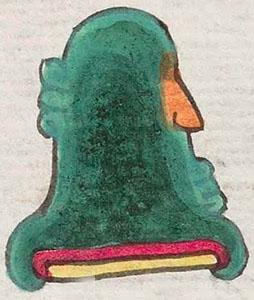Tepeyacac (Mdz42r)
This compound glyph stands for the place name Tepeyacac (Tepeyac, today). It consists of a hill or mountain (tepetl) with a nose on the right side. The rocky outcropping has been moved lower on that side of the hill to accommodate the placement of the nose (yacatl) at the center of the slope and in a profile view, facing to the viewer's right. The mountain is the usual two-tone green with the horizontal red and yellow stripes at its base. The nose is colored terracotta.
Stephanie Wood
The nose is not there for any semantic meaning relating to human anatomy. Rather, the nose was meant to bring up "point," in particular the mountain peak. The "yaca" from yacatl has been given a locative final -c, creating the postposition -yacac (locative, telling where).
Stephanie Wood, drawing from the work of Gordon Whittaker
tepeacac. puo
Tepeyacac, pueblo
Stephanie Wood
c. 1541, but by 1553 at the latest
Stephanie Wood
mountains, hills, peaks, picos, cerros, montañas, nombres de lugares

tepe(tl), hill or mountain, https://nahuatl.wired-humanities.org/content/tepetl
yacat(l), nose, point, peak, https://nahuatl.wired-humanities.org/content/yacatl
-yacac (locative suffix), on the rim of, https://nahuatl.wired-humanities.org/content/yacac
"At the Point of the Mountain" [Gordon Whittaker, Deciphering Aztec Hieroglyphs, 2021, 106]
TEPE•YACA.
En el Pico de la Montaña
Stephanie Wood
Codex Mendoza, folio 42 recto, https://digital.bodleian.ox.ac.uk/objects/2fea788e-2aa2-4f08-b6d9-648c00..., image 94 of 188.
The Bodleian Libraries, University of Oxford, hold the original manuscript, the MS. Arch. Selden. A. 1. This image is published here under the UK Creative Commons, “Attribution-NonCommercial-ShareAlike 3.0 License” (CC-BY-NC-SA 3.0).



